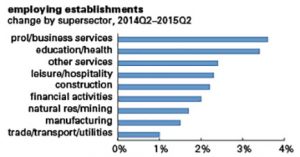How Disruptive is That?
Strong growth in transportation and warehousing, led by limo services (which is where Uber and the like would show up if they are getting picked up), has added fuel to the argument that Uber is a disruptive technology. That’s going to be hard to prove: the author of the theory of disruptive innovation, Harvard Business Schools’s Clayton Christensen, argues that it isn’t.
It’s worth taking a look at the article. Christensen at al. suggest that his theory may is “in danger of becoming a victim of its own success,” and that many of the people who throw it around have not “read a serious book or article on the subject.” In his recap he notes that his use of “disruption” relates to the process in which established businesses are challenged by small companies with fewer resources. He notes that incumbent companies tend to focus on the demands of their most demanding (read lucrative) clients, which causes them to go too far for some segments, and not far enough for others. The newcomer targets the neglected segments, and offers services, generally at lower prices, to them. The established businesses remain focused on their higher paying clients, allowing the newcomers to move up the ladder. Disruption occurs when mainstream customers flock to the newcomers’ offerings. Christensen suggests that Uber is not disruptive because it doesn’t cater to the low end of the market, and because the product it offers is not perceived as lower quality than current taxi services.
So remember, if you want to be a disruptive technology, you have to start out cheap and bad, and then get better while remaining cheap.




